Located in southeastern Virginia, Virginia Beach is a long stretch of oceanfront beach that attracts visitors from up and down the east coast. The popular beachfront runs for about 35 miles and includes multiple regions, each with its own unique attractions. Virginia Beach is the largest pleasure beach in the world, according to the Guinness Book of World Records.
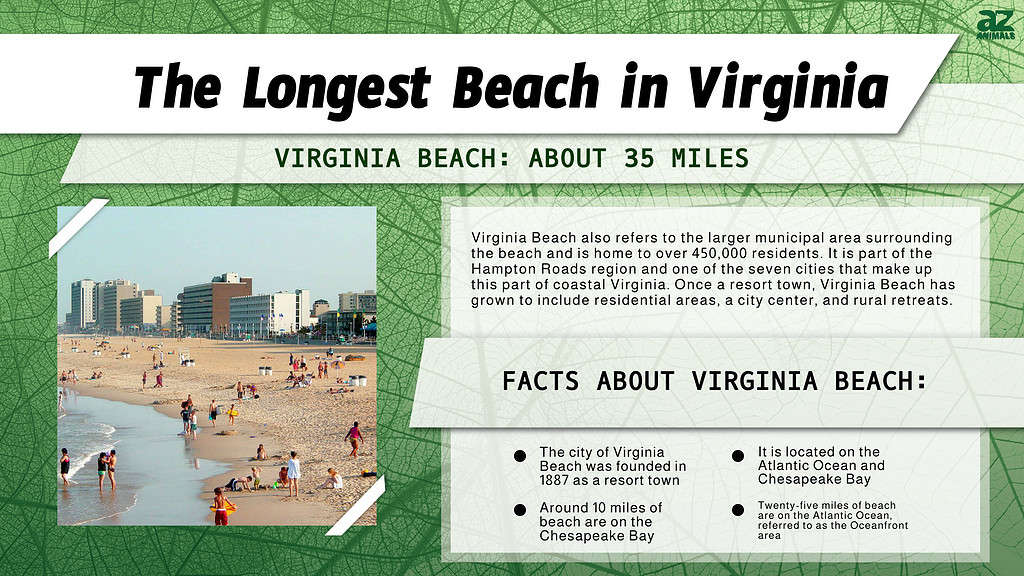
Virginia Beach also refers to the larger municipal area surrounding the beach and is home to over 450,000 residents. It is part of the Hampton Roads region and one of the seven cities that make up this part of coastal Virginia. Once a resort town, Virginia Beach has grown to include residential areas, a city center, and rural retreats. It still retains its beachy charm, however, making it one of the best places to enjoy the beach on the East Coast.
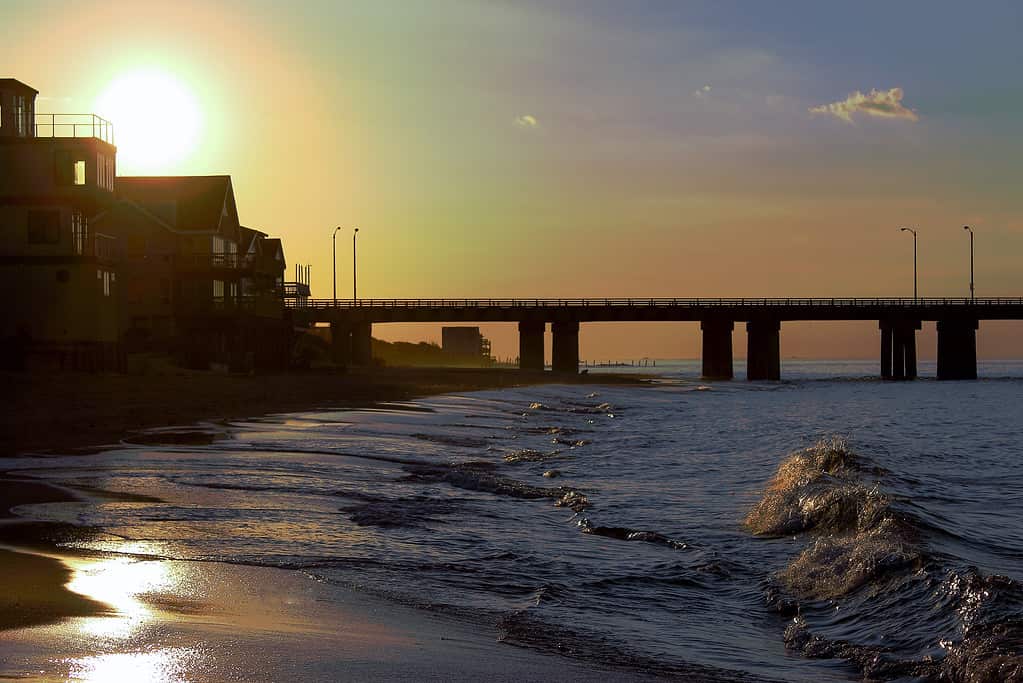
Chic’s Beach in Virginia Beach is a calm section on the Chesapeake Bay.
©Brandon Gray/Shutterstock.com
Where is Virginia Beach?
The actual beach in Virginia Beach is located on the Atlantic Ocean and Chesapeake Bay. The city of Virginia Beach includes both. Around 10 miles of beach are on the Chesapeake Bay. Another 25 miles are on the Atlantic Ocean, commonly referred to as the Oceanfront area. This stretch of beach includes a 3-mile boardwalk and the iconic statue of King Neptune that has come to be associated with Virginia Beach.
Virginia Beach is in the southeastern corner of the state, right on the coast. It is close enough to North Carolina that some people live in one state and work in the other. Portions of the city are urbanized, although there are still many residential and even rural sections around Virginia Beach. The Chesapeake Bay Bridge-Tunnel runs from Virginia Beach to the eastern shore.
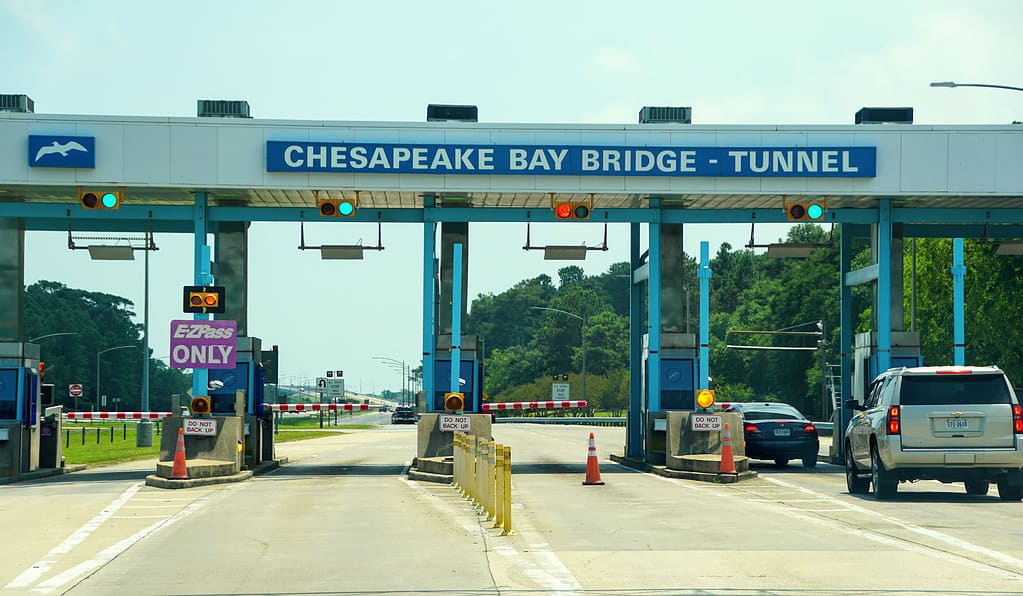
The Chesapeake Bay Bridge Tunnel passes right by the beaches of Virginia Beach.
©Khairil Azhar Junos/Shutterstock.com
History of Virginia Beach
The city of Virginia Beach was founded in 1887 as a resort town. The beach has always been a big draw for visitors and residents. Many people came from nearby Norfolk, Virginia. Even today, people who live in Virginia Beach often work in Norfolk or other surrounding areas. As the area expanded, the beach remained one of the biggest attractions. These days, it is a popular destination for families during the summer, students on holidays like spring break, and even as a day trip for those living nearby.
The first settlers to arrive in Virginia landed in this area in 1607 before continuing on to Jamestown, which is just over an hour away. First Landing State Park commemorates their landing and is a great place to visit. The oceanfront, which is one of the better-known and visited beaches in Virginia Beach, has always been home to a variety of resort-style hotels. The Cavalier Hotel hosted celebrities and political figures, including Frank Sinatra, F. Scott Fitzgerald, and seven presidents. You can still visit the hotel and stay in one of its luxurious rooms overlooking the oceanfront.

The 34-foot tall statue of King Neptune at the Virginia Beach boardwalk greets visitors.
©/Shutterstock.com
Fun Things to Do in Virginia Beach
There are plenty of ways to enjoy a day in Virginia Beach, both by the water and on land.
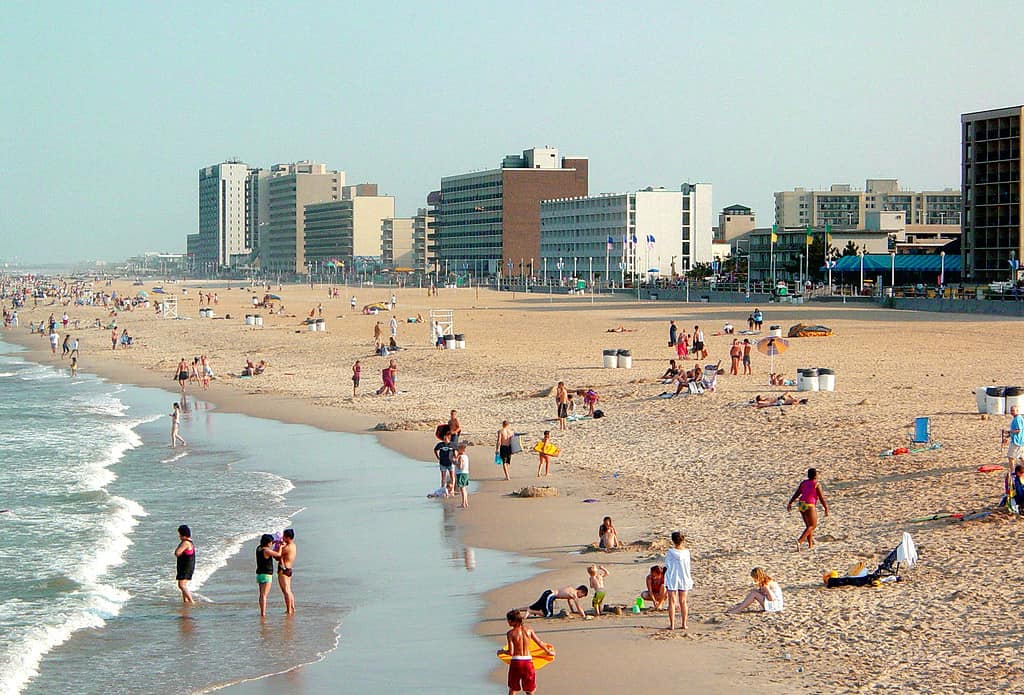
According to the Guinness Book of World Records, Virginia Beach is the largest pleasure beach in the world.
Oceanfront Beach Vibes
The oceanfront is the busiest and most lively part of the beach. It has all of the things you would expect, including casual dining, nice seafood restaurants, mini golf, and plenty of sand. This is also the area where you’ll find the boardwalk. There are plenty of festivals to enjoy during the warmer parts of the year.
Grommet Island Park is also located in this section of the beach. It is a large playground located right on the sand for kids to play on. There are also agility obstacles nearby, as well as structures and accommodations for those with mobility challenges.
Chic’s Beach
This quieter beach is located on the Chesapeake Bay, which means calmer waves and (usually) less crowds. There aren’t as many dining options and parking can be tricky. But it’s an ideal spot for people with young kids or those who just want a more laid-back beach feel. Golf carts are also allowed to be driven on the road in parts of the neighborhoods surrounding Chic’s Beach. It’s important to follow posted signs, of course.
First Landing Beach
This state park has hiking trails, campsites, and plenty of beach space. You will need to pay for parking and bring any food and drinks with you since there aren’t restaurants within walking distance once you enter the park. Fortunately, there are plenty of great spots just outside the entrance that you can stop at on your way. There are two sections of the park on either side of Shore Drive, the main thoroughfare through this part of Virginia Beach. It is also right next to Fort Story where you can see the two Cape Henry Lighthouses. These are some of the most historic and picturesque lighthouses in the entire state of Virginia.
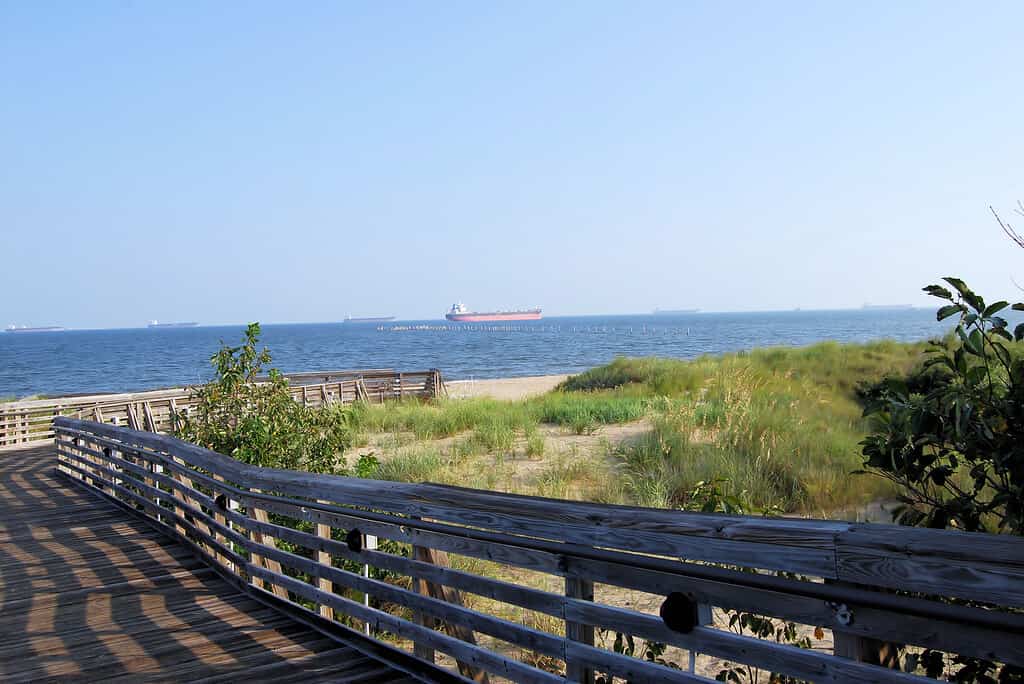
First Landing Beach is where English colonists first landed in 1607.
Sandbridge Beach
This spot is popular with families coming for an extended beach vacation. There are plenty of short-term rental options right on the beach. It is located on the southern end of Virginia Beach away from the busier beaches of the Oceanfront. If you want to spend a week at the beach focusing on the waves and the sand, this is the spot to do it. It is also close to the Back Bay National Wildlife Refuge for those who want to see some wildlife during their trip.
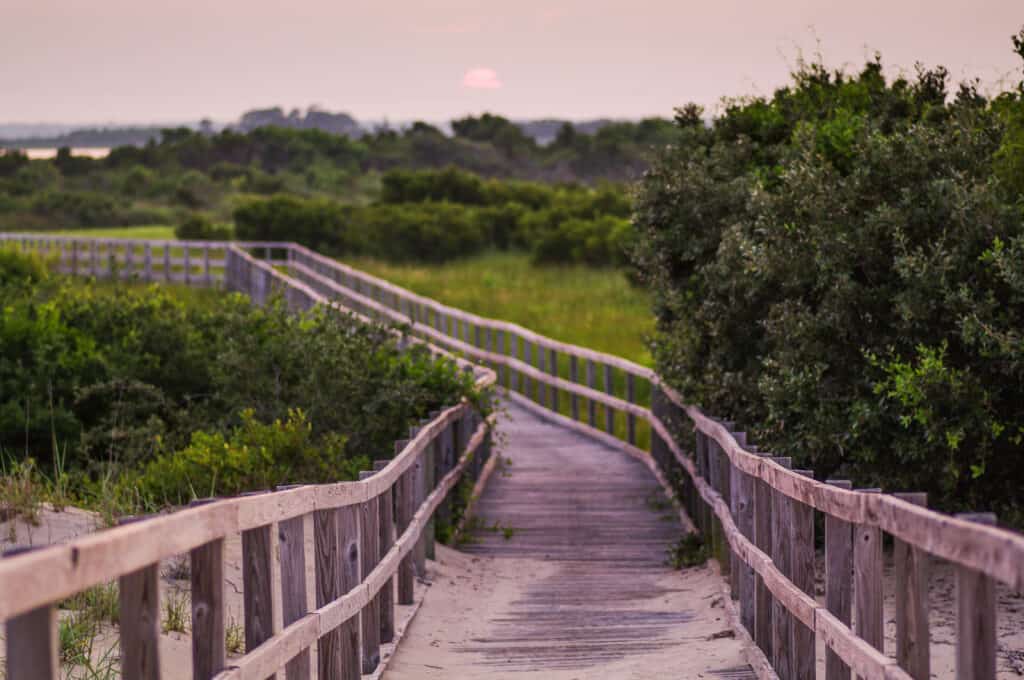
The boardwalk at Back Bay National Wildlife Refuge is one way to view wildlife in the marshes from a safe distance.
©Outlook/Shutterstock.com
Animals in Virginia
The city of Virginia Beach is home to many animals, including deer, raccoons, and foxes. But a lot of the more elusive species are at home in the wilderness areas outside of the city. Back Bay National Wildlife Refuge ensures protected habitat for many species, especially waterfowl. Bald eagles, peregrine falcons, and ducks are plentiful. Cottonmouth snakes are also at home in this refuge, something that visitors should be aware of before stopping by.
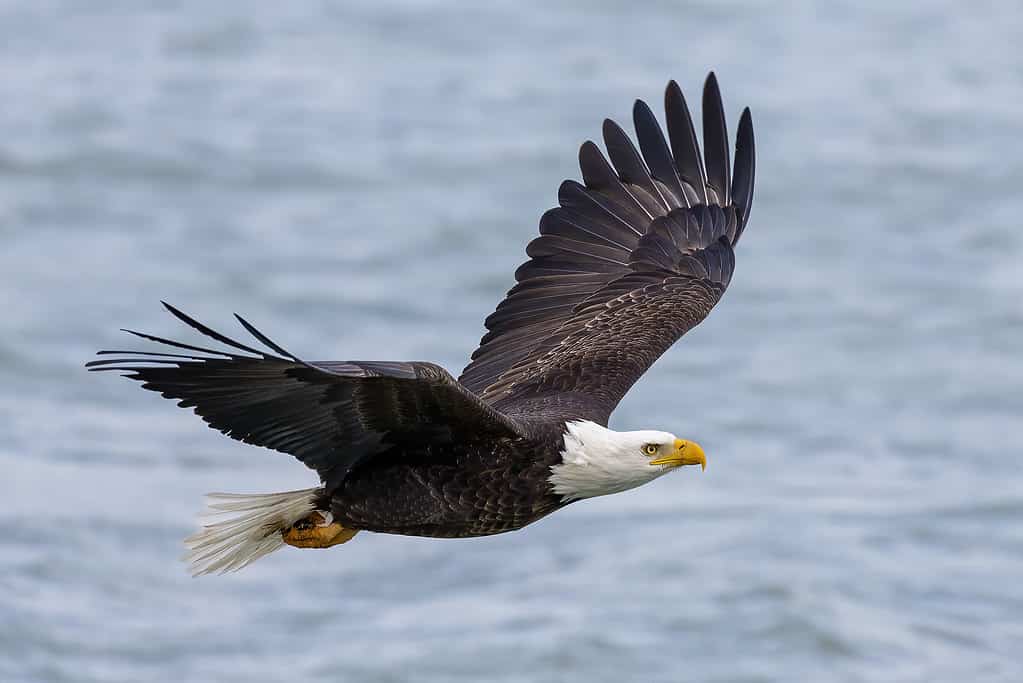
Bald eagles are typically found near bodies of water.
©iStock.com/Karel Bock
Marine Life in the Chesapeake Bay
A lot of the most interesting species in Virginia Beach don’t live on the beach but under the waves. People see dolphins from the beach and can even take dolphin observation trips from the nearby Virginia Aquarium and Marine Science Center. Humpback whales are also common, especially in the winter months. Shark sightings happen but are rare. Sandbar sharks are some of the most common sharks seen in these waters and often come close to shore. Blacktip sharks, hammerhead sharks, tiger sharks, and aggressive bull sharks are the larger sharks seen in the area.
One of the best ways to learn more about life under the sea in the Atlantic Ocean and the Chesapeake Bay is to visit the Aquarium. It is located near the beach and perfect for an overcast day or when you want a break from sitting by the waves. Exhibits include large tanks with native species like sharks and rays, exotic species from around the world, and interactive exhibits for kids. The aquarium also hosts special events, such as a bay cleanup day and cruises on the water, led by experts who can teach you more about the species you see.
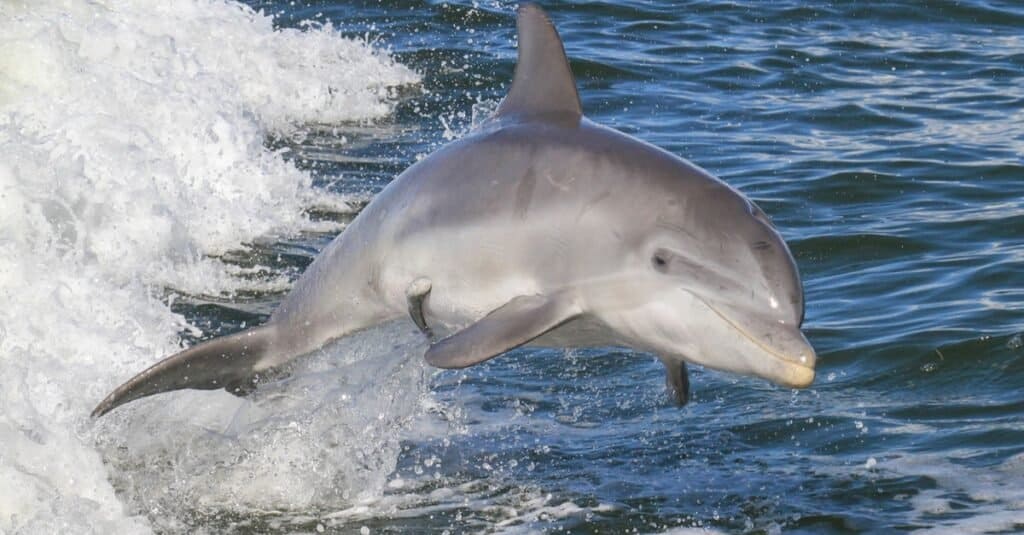
An Atlantic
Bottlenose Dolphin
(Tursiops truncatus) jumping out of the water. Dolphins can use echolocation to find fish in murky water or objects buried in the sand.
©Tory Kallman/Shutterstock.com
Thank you for reading! Have some feedback for us? Contact the AZ Animals editorial team.








